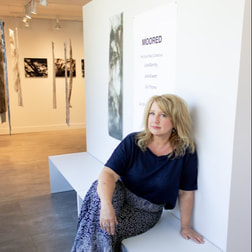We know what loneliness is like. Loneliness is built into our commodified, mass-marketed bodies. The female character recurs in this artist’s work. Like an Andy Warhol Madonna. It could be someone’s avatar on social media. It could be any one of us. If there was a QR code to scan here, we would be raising our phones prayerfully to inhabit this icon’s digital dimension.
In the exquisite lettering around her – EXQS – we discern the hint of a hammer and sickle in the Q. The five-corner stars we noticed before now begin to acquire meaning. The circled anarchist A in one corner is balanced by the heart in the opposite. Arrows suggest movement – the movement of the mind, language, towards alternatives. If we can find a way not to be alone together, perhaps our social system would be different.
Waking up to a system of exploitation can be lonely business. To be alone is also a prerequisite for awareness, knowledge. To be aware and alone yet not lonely – perhaps that is the hardest of all. And here in this Lake Country skate park, several artists have come together for the first time to create something new out of highly individualized styles. In a dialogue of style and meaning new possibilities emerge.
Working with the manic intensity of a Michelangelo, Doktoer has been up through the night, improvising a dense web of free-form connections.
The space now is less a gallery and more a chapel – where you commune with the truth not in still supplication, but through movement. And if you ever stop, you stop midair.
Slava Bart is a first-year international MFA student at UBCO. He comes from Israel and enjoys multilingual and collaborative writing with a penchant for venturing deep into the past and far into the future, reaching across borders and disciplines, to promote community and peace. His thesis in poetry reinterprets the books of Genesis and Exodus using multiple languages to tell a personal story of the loss of home after the collapse of the USSR.














 RSS Feed
RSS Feed

